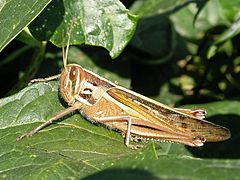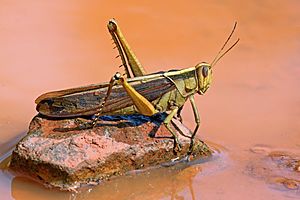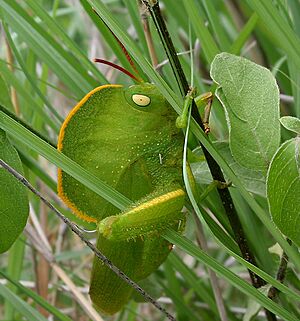Orthoptera facts for kids
Quick facts for kids Orthoptera |
|
|---|---|
 |
|
| Patanga japonica | |
| Scientific classification | |
| Kingdom: | |
| Phylum: | |
| Class: | |
| Subclass: | |
| Infraclass: | |
| (unranked): | |
| Order: |
Orthoptera
|
Orthoptera is a group of insects that includes grasshoppers, katydids, and crickets. The name "Orthoptera" comes from Greek words meaning "straight wings." This is because their front wings, called tegmina, are stiff and straight. They are not used for flying.
The back wings are thin and fold like a fan under the front wings when the insect is not flying. Many Orthoptera use their wings to make sounds, which we often call "chirping."
Contents
Life Cycle

Orthopteran insects begin their lives inside an egg case. After about three weeks, or when spring arrives, tiny nymphs hatch from the eggs.
These nymphs look like small adults but do not have wings yet. After they molt (shed their skin) four or five times, they grow wings. This means they are now adults and are ready to have their own babies.
How Orthoptera Make Sounds
Orthoptera make their unique sounds by rubbing parts of their bodies together. They often use file-like edges on their wings or special wing veins. Some groups rub their wing edges together. Others rub a back leg against a wing edge.
Each species makes a unique sound. This sound helps them find a mate. Only the males make these sounds, and females move towards the sound to find a male.
What Orthoptera Eat
Members of the Orthoptera group chew their food using strong mandibles, which are like jaws. Their diet can vary a lot.
Crickets are omnivores, meaning they eat both plants and animals. They will eat almost anything, including vegetables, cereal, and even another cricket if they are very hungry. Katydids are mostly plant eaters (herbivores). However, they might also eat another katydid if they are hungry. They also enjoy eating small, slow-moving creatures like aphids.
Grasshoppers almost always eat plants. They love grass, wheat bran, and lettuce. Because they eat so many plants, they can sometimes be serious crop pests for farmers.
Amazing Jumpers
It can be quite tricky to catch an Orthoptera insect because they are amazing jumpers. They have incredibly strong legs. For example, a grasshopper can jump 20 times farther than its own body length!
Their back legs are very large and long. These powerful legs give these insects their incredible ability to jump far and fast.
Types of Orthoptera
Crickets, katydids, and grasshoppers are all part of the Orthoptera group because they share many similar features. However, there are also several ways to tell them apart.
First, their colors are usually different. Grasshoppers are active during the day, so their colors often match their surroundings. They are usually green, light brown, or have many different colors (multicolored) to blend in with grass and bright flowers. Crickets are active at night, so they are usually dark. Katydids spend a lot of time on leaves, so they are often leaf-colored. Their wings can even look like leaves, with similar vein patterns and small brown spots.
Second, their behaviors are different. Grasshoppers are most active during the day. Crickets are active at night. Katydids prefer to be active in the late afternoon and evening.
Third, their antennae are different. Katydids and crickets usually have long, thin antennae. Grasshoppers, on the other hand, usually have short, thick antennae. This rule is not always perfect, though. For example, some grasshoppers, like the long-horned grasshopper, have long, thin antennae, making them look more like crickets. Because of these exceptions, it can sometimes be hard to tell members of this group apart.
Related Pages
Images for kids
-
Variegated grasshopper (Zonocerus variegatus), Ghana, family Pyrgomorphidae
See also
 In Spanish: Ortópteros para niños
In Spanish: Ortópteros para niños




